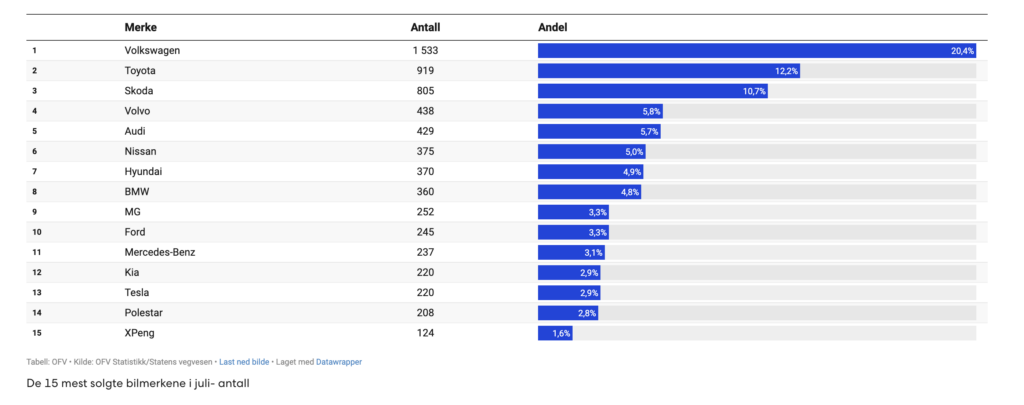New car registrations in July: Back to normal
In July, 7,525 new passenger cars were registered, 278 more (+ 3.8%) than in July 2022. So far this year, 74,072 new passenger cars have been registered, 1,671 fewer (- 2.2%) than in the first half of 2022 Among the new passenger cars, zero-emission cars had an 81.7 percent market share in July, for the first half of the year the market share for zero-emission cars is 83.0%. Average CO2 emissions for all passenger cars registered in July were 15.7 g/km.
After a somewhat special first half of the year, July 2023 was a more “normal” month measured in the number of first-time registered new passenger cars. The fierce Tesla dominance from the first six months seems to have taken a break, and traditional car brands such as Volkswagen, Toyota and Skoda took the top three places in July.
In July, 7,525 new passenger cars were registered – a slight increase (+3.8 per cent) compared to July 2022. In total, 74,072 new passenger cars have been registered so far this year, a decrease of 2.2 per cent compared to the same period in 2022.
Tesla is still Norway’s most popular new passenger car, but the lead over the next car brands, Volkswagen and Toyota, narrowed during July. Many car brands have had very good promotional offers on certain car models, and we can see from the statistics in July that more new car buyers have known their visit time, says director Øyvind Solberg Thorsen of the Road Information Council (OFV).
In particular, new cars from Volkswagen, Toyota, Skoda and Volvo and Audi have been popular. These car brands have been available in stock, and new cars have therefore been able to be delivered to customers quickly.
Stable share of electric cars The share of new electric passenger cars amounted to approx. 82 per cent in July and 83 per cent so far this year – a level that has been stable for some time.
It may seem as if the share of electric cars has reached a threshold level that is difficult to cross, says Solberg Thorsen. He points out that the general increase in prices and the level of interest rates have probably reduced the desire to buy for some car buyers, and that the increased taxes that came on 1 January 2023 also have a clear dampening effect.
It will be exciting to see what happens when several new electric car models in different price ranges are launched during the autumn and winter, he says.
It is plug-in hybrids and hybrids that are most popular in July, after electric cars. Together, these powertrains had about 14 per cent of the market, while pure diesel and petrol cars accounted for a combined share of 4.3 per cent.
The used car market at the same level as in 2022 Every single month so far this year, the number of changes of ownership has been on a par with last year, and July was no exception. In the month of July, 43,575 passenger cars were re-registered, 0.9 per cent more than in July 2022. By the end of July, 300,456 passenger cars had changed hands, that’s approx. 1,400 more cars (+ 0.5 per cent) than the same period in 2022. It is still diesel and petrol cars that are most popular on the used market, even though the proportion of electric cars is increasing.
Imports of used cars have almost stopped, and in July 370 used imported cars were registered in Norway – that is 67.2 percent fewer than in July 2022. In total, there have been 2,328 used imported cars so far this year, compared to 9,677 in 2022 37.8 per cent of the used imported passenger cars are electric cars.
More and more electric vans In July, 1,208 new vans were registered, of which 353 (29.2 per cent) were electric. So far this year, there have been 13,958 new vans on Norwegian roads, an increase of 0.3 per cent compared to the same period last year. Of these, 4,781 are electric, an increase in number of 63.6 per cent. The proportion of new electric vans now amounts to 34.3 per cent. New diesel vans still dominate, with a share of 62.9 per cent.
(ALL FIGURES FROM OFV)


